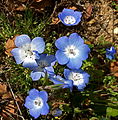
Nemophila is a genus found in the flowering plant family Boraginaceae.

Eriophyllum lanatum, with the common names common woolly sunflower, Oregon sunshine and golden yarrow, is a common, widespread, North American plant in the family Asteraceae.

Salvia columbariae is an annual plant that is commonly called chia, chia sage, golden chia, or desert chia, because its seeds are used in the same way as those of Salvia hispanica (chia). It grows in California, Nevada, Utah, Arizona, New Mexico, Sonora, and Baja California, and was an important food for Native Americans. Some native names include pashiiy from Tongva and it'epeš from Ventureño.

Nemophila maculata, commonly known as fivespot, is a species of flowering plant in the borage family (Boraginaceae).
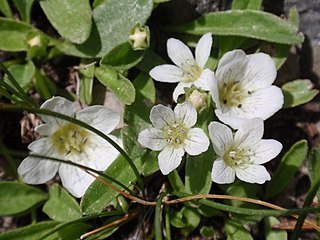
Nemophila spatulata, with the common names Sierra baby blue-eyes and Sierra nemophila, is a dicot in the family Boraginaceae.

Baccharis pilularis, called coyote brush, chaparral broom, and bush baccharis, is a shrub in the family Asteraceae native to California, Oregon, Washington, and Baja California. There are reports of isolated populations in New Mexico, most likely introduced.
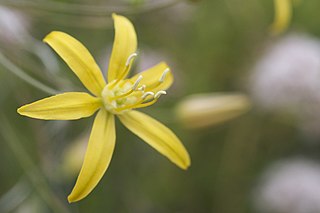
Bloomeria crocea, also known as goldenstar, is a geophyte from southern California and northern Baja California. It is found along hillsides, in grassland and chaparral edges, and in dry flats.

Eriogonum fasciculatum is a species of wild buckwheat known by the common names California buckwheat and flat-topped buckwheat. Characterized by small, white and pink flower clusters that give off a cottony effect, this species grows variably from a patchy mat to a wide shrub, with the flowers turning a rusty color after blooming. This plant is of great benefit across its various habitats, providing an important food resource for a diversity of insect and mammal species. It also provides numerous ecosystem services for humans, including erosion control, post-fire mitigation, increases in crop yields when planted in hedgerows, and high habitat restoration value.

Acanthomintha duttonii is a species of annual plant endemic to San Mateo County, California in the family Lamiaceae. It is commonly called San Mateo thornmint and is found growing on serpentine soils near the Crystal Springs Reservoir in a six-mile (10 km) long strip on the east side of Montara Mountain at elevations of approximately 150 to 300 meters.

Lupinus bicolor is a species of lupine known as the miniature lupine, Lindley's annual lupine, pigmy-leaved lupine, or bicolor lupine.

Emmenanthe is a monotypic genus which contains only one species, Emmenanthe penduliflora, known by the common name whispering bells. This grassland wildflower is native to California, though it can also be found in other locations within western North America.

Chorizanthe fimbriata, the fringed spineflower, is an annual plant in the family Polygonaceae, the buckwheats. It is a member of the genus Chorizanthe, the spineflowers, and is native to southern California and northern Baja California.

Mentzelia veatchiana is a species of flowering plant in the family Loasaceae known by the common name Veatch's blazingstar.

Nemophila heterophylla is a species of flowering plant in the borage family known by the common name small baby blue eyes.
Nemophila pulchella, known by the common name Eastwood's baby blue-eyes, is a species of flowering plant in the borage family. It is endemic to California, where it is found from the San Francisco Bay Area to the southern Sierra Nevada to the Transverse Ranges. It grows in many types of mountain, foothill, and valley habitats.
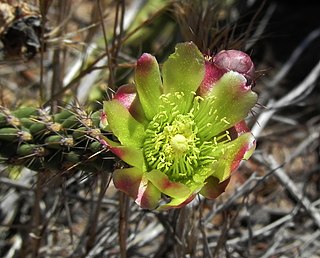
Cylindropuntia californica is a species of cholla cactus known by the common name snake cholla. It is primarily found in Baja California, Mexico and the southernmost part of California in the United States. It is characterized by a short, decumbent habit, yellow-green flowers, elongated stems, and short spines. It is mostly found in coastal sage scrub and coastal chaparral habitats, but two varieties in Baja California can be found in foothills and deserts. In California, variety californica is regarded as a rare and threatened plant, with a California Native Plant Society listing of 1B.1, in part due to its limited number of occurrences and threats from development. It formerly was considered to have a larger range due to the inclusion of Cylindropuntia bernardina within it as the variety parkeri.
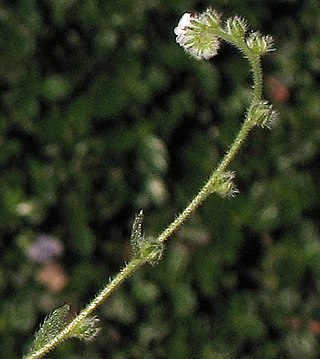
Plagiobothrys collinus is a species of flowering plant in the borage family known by the common name Cooper's popcornflower.
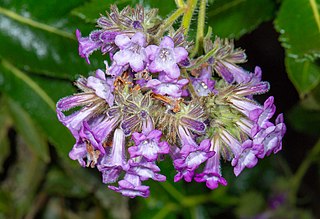
Eriodictyon sessilifolium, known by the common names Baja California yerba santa, sessile-leaved yerba santa or sessileleaf yerba santa is a perennial shrub in the Boraginaceae family, near-endemic to Baja California but also rarely found in the southern California, in a locality near Poway.


